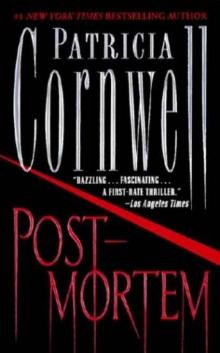- Home
- Patricia Cornwell
Predator Page 2
Predator Read online
Page 2
He gets up from his chair, and his big presence seems even bigger, and he makes her feel even smaller than he used to make her feel. He picks up his useless helmet and puts on his sunglasses. He hasn’t looked at her throughout their entire conversation, and now she can’t see his eyes at all. She can’t see what’s in them.
“I’ll give it my complete attention. Immediately,” she says as he walks to the door. “If you’d like to go over it later, we can.”
“Huh.”
“Why don’t you come to the house?”
“Huh,” he says again. “What time?”
“Seven,” she says.
2
Inside the MRI suite, Benton Wesley watches his patient through a partition of Plexiglas. The lights are low, multiple video screens illuminated along the wraparound counter, his wristwatch on top of his briefcase. He is cold. After several hours inside the cognitive neuroimaging laboratory, even his bones are cold, or at least that’s how it feels.
Tonight’s patient goes by an identification number, but he has a name. Basil Jenrette. He is a mildly anxious and intelligent thirty-three-year-old compulsive murderer. Benton avoids the term serial killer. It has been so overused, it means nothing helpful and never did except to loosely imply that a perpetrator has murdered three or more people over a certain period of time. The word serial suggests something that occurs in succession. It suggests nothing about a violent offender’s motives or state of mind, and when Basil Jenrette was busy killing, he was compulsive. He couldn’t stop.
The reason he is getting his brain scanned in a 3-Tesla MRI machine that has a magnetic field sixty thousand times more powerful than the earth’s is to see if there is anything about his gray and white matter and how it functions that might hint at why. Benton has asked him why numerous times during their clinical interviews.
I would see her and that was it. I had to do it.
Had to do it right that minute?
Not right there on the street. I might follow her until I figured it out, came up with a plan. To be honest, the more I calculated, the better it felt.
And how long would this take? The following, the calculating. Can you approximate? Days, hours, minutes?
Minutes. Maybe hours. Sometimes days. Depends. Stupid bitches. I mean, if it was you and you realized you were being abducted, would you just sit there in the car and not even try to get away?
Is that what they did, Basil? They sat in the car and didn’t try to get away?
Except for the last two. You know about them because that’s why I’m here. They wouldn’t have resisted, but my car broke down. Stupid. If it was you, would you rather be killed right there in the car or wait to see what I’m going to do to you when I get you to my special spot?
Where was your special spot? Always the same place?
All because my damn car broke down.
So far, the structure of Basil Jenrette’s brain is unremarkable except for the incidental finding of a posterior cerebellar abnormality, an approximately six-millimeter cyst that might affect his balance a little, but nothing else. It is the way his brain functions that isn’t quite right. It can’t be right. If it were, he wouldn’t have been a candidate for the PREDATOR research study, and he probably wouldn’t have agreed to it. Everything is a game to Basil, and he is smarter than Einstein, thinks he is the most gifted person on earth. He has never suffered one moment of remorse for what he’s done and is quite candid in saying that he would kill more women given the opportunity. Unfortunately, Basil is likeable.
The two prison guards inside the MRI suite vacillate from confused to curious as they stare through the glass at the seven-foot-long tube, the bore of the magnet, on the other side. The guards wear uniforms but no guns. Weapons aren’t allowed in here. Nothing ferrous, including handcuffs and shackles, is permitted, and only plastic flex-cuffs restrain Basil’s ankles and wrists as he lies on the table inside the magnet, listening to the jarring knocks and wonks of radio-frequency pulses that sound like infernal music played on high-voltage power lines—or that’s what Benton imagines.
“Remember, this next one is color blocks. All I want you to do is name the color,” Dr. Susan Lane, the neuropsychologist, says into the intercom. “No, Mr. Jenrette, please don’t nod your head. Remember, the tape is on your chin to remind you not to move.”
“Ten-four,” Basil’s voice sounds through the intercom.
It is half past eight at night and Benton is uneasy. He has been uneasy for months, not so much worried that the Basil Jenrettes of the world are going to suddenly explode into violence inside the gracious old brick walls of McLean Hospital and slaughter everything in sight, but that the research study is doomed to failure, that it is a waste of grant money and a foolish expenditure of precious time. McLean is an affiliate of Harvard Medical School, and neither the hospital nor the university is forgiving about failure.
“Don’t worry about getting all of them right,” Dr. Lane is saying over the intercom. “We don’t expect you to get all of them right.”
“Green, red, blue, red, blue, green.” Basil’s confident voice fills the room.
A researcher marks down results on a data-entry sheet while the MRI technician checks images on his video screen.
Dr. Lane pushes the talk button again. “Mr. Jenrette? You’re doing an excellent job. Can you see everything okay?”
“Ten-four.”
“Very good. Every time you see that black screen, you are nice and still. No talking, just look at the white dot on the screen.”
“Ten-four.”
She releases the talk button and says to Benton, “What’s with the cop jargon?”
“He was a cop. That’s probably how he was able to get his victims into his car.”
“Dr. Wesley?” the researcher says, turning around in her chair. “It’s for you. Detective Thrush.”
Benton takes the phone.
“What’s up,” he asks Thrush, a homicide detective with the Massachusetts State Police.
“I hope you weren’t planning on an early bedtime,” Thrush says. “You hear about the body found this morning out by Walden Pond?”
“No. I’ve been locked up in this place all day.”
“White female, unidentified, hard to tell her age. Maybe in her late thirties, early forties, shot in the head, the shotgun shell shoved up her ass.”
“News to me.”
“She’s been autopsied already, but I thought you might want to take a look. This one ain’t the average bear.”
“I’ll be finished up in less than an hour,” Benton says.
“Meet me at the morgue.”
The house is quiet and Kay Scarpetta walks from room to room, turning on every light, unsettled. She listens for the sound of a car or a motorcycle, listens for Marino. He is late and hasn’t returned her phone calls.
Unsettled and anxious, she checks to make sure that the burglar alarm is armed and the floodlights are on. She pauses at the video display on the kitchen phone to make sure the cameras monitoring the front, back and sides of her house are operating properly. Her property is shadowy in the video display, and dark images of citrus trees, palms and hibiscus move in the wind. The dock behind her swimming pool and the waterway beyond are a black plain dabbed with blurred lights from lamps along the seawall. She stirs tomato sauce and mushrooms in copper pots on the stove. She checks dough rising and fresh mozzarella soaking in covered bowls by the sink.
It is almost nine, and Marino was supposed to be here two hours ago. Tomorrow she is tied up with cases and teaching, and she doesn’t have time for his rudeness. She feels set up. She has had it with him. She has worked nonstop on the Johnny Swift alleged suicide for the past three hours, and now Marino can’t bother to show up. She is hurt, then angry. It is easier to be angry.
She is very angry as she walks into her living room, still listening for a motorcycle or a car, still listening for him. She picks up a twelve-gauge Remington Marine Magnum from her couch and sits dow
n. The nickel-plated shotgun is heavy in her lap, and she inserts a small key in the lock. She turns the key to the right and pulls the lock free from the trigger guard. She racks the pump back to make sure there are no cartridges in the magazine.
3
We’re going to do word reading now,” Dr. Lane is telling Basil over the intercom. “Just read the words from left to right. Okay? And remember, don’t move. You’re doing great.”
“Ten-four.”
“Hey, want to see what he really looks like?” the MRI technician says to the guards.
His name is Josh. He majored in physics at MIT, is working as a tech while working on his next degree, is bright but eccentric with a twisted sense of humor.
“I already know what he looks like. I got to escort him to the showers earlier today,” one of the guards says.
“Then what?” Dr. Lane asks Benton. “What would he do to them after he got them into his car?”
“Red, blue, blue, red…”
The guards wander closer to Josh’s video screen.
“Take them someplace, stab them in the eyes, keep them alive a couple days, rape them repeatedly, cut their throats, dump their bodies, pose them to shock people,” Benton is telling Dr. Lane matter-of-factly, in his clinical way. “The cases we know about. I’m suspicious he killed others. A number of women vanished in Florida during the same time frame. Presumed dead, bodies never found.”
“Take them where? A motel, his house?”
“Hold on a second,” Josh says to the guards as he selects the menu option 3D, then SSD, or Surface Shading Display. “This is really cool. We never show it to patients.”
“How come?”
“Totally freak them out.”
“We don’t know where,” Benton is telling Dr. Lane as he keeps a check on Josh, ready to intervene if he gets too carried away. “But it’s interesting. The bodies he dumped. They all had microscopic particles of copper on them.”
“What on earth?”
“Mixed in with dirt and whatever else was adhering to blood, their skin, in their hair.”
“Blue, green, blue, red…”
“That’s very strange.”
She pushes the talk button. “Mr. Jenrette? How are we doing in there? You okay?”
“Ten-four.”
“Next, you’re going to see words printed in a different color from what they spell. I want you to name the color of the ink. Just name the color.”
“Ten-four.”
“Isn’t this awesome?” Josh says as what looks like a death mask fills his screen, a reconstruction of one-millimeter-thick, high-resolution slices that make up the MRI scan of Basil Jenrette’s head, the image pale, hairless and eyeless, ending raggedly just below the jaw as if he has been decapitated.
Josh rotates the image so the guards can see it from different angles.
“Why’s his head look cut off?” one of them asks.
“That’s where the signal from the coil stopped.”
“His skin doesn’t look real.”
“Red uh green, blue I mean red, green…” Basil’s voice enters the room.
“It’s not really skin. How to explain…well, what the computer’s doing is volume reconstruction, a surface rendering.”
“Red, blue uh green, blue I mean green…”
“Only thing we really use it for is PowerPoints, mainly, to overlay structural with functional. Just an fMRI analysis package where you can put data together and look at it any way you want, have fun with it.”
“Man, he’s ugly.”
Benton has heard enough. The color naming has stopped. He gives Josh a sharp look.
“Josh? You ready?”
“Four, three, two, one, ready,” Josh says, and Dr. Lane begins the interference test.
“Blue, red, I mean…shit, uh, red, I mean blue, green, red…” Basil’s voice violates the room as he gets all of them wrong.
“He ever tell you why?” Dr. Lane asks Benton.
“I’m sorry,” he says, distracted. “Why what?”
“Red, blue shit! Uh red, blue-green…”
“Why he gouged their eyes out.”
“He said he didn’t want them to see how small his penis is.”
“Blue, blue-red, red, green…”
“He didn’t do so well on this one,” she says. “In fact, he missed most of them. What police department did he work for, so I remember not to get pulled for speeding in that part of the world?” She pushes the talk button. “You okay in there?”
“Ten-four.”
“Dade County PD.”
“Too bad. I’ve always liked Miami. So that’s how you managed to conjure this one up. Because of your South Florida connections,” she replies, pushing the talk button again.
“Not exactly.” Benton stares through the glass at Basil’s head in the far end of the magnet, imagining the rest of him dressed like a normal person in jeans and a button-up white shirt.
The inmates are not allowed to wear prison fatigues on the hospital campus. It’s bad public relations.
“When we began querying state penitentiaries for study subjects, Florida thought he was just the guy for the job. He was bored. They were happy to get rid of him,” Benton says.
“Very good, Mr. Jenrette,” Dr. Lane says into the intercom. “Now, Dr. Wesley is going to come in and give you the mouse. You’re going to see some faces next.”
“Ten-four.”
Ordinarily, Dr. Lane would go into the MRI room and deal with the patient herself. But women doctors and scientists are not allowed physical contact with the subjects of PREDATOR. Male doctors and scientists have to be cautious, too, while inside the MRI suite. Outside of it, restraining research study subjects during interviews is up to the clinician. Benton is accompanied by the two prison guards as he turns on the lights inside the MRI room and shuts the door. The guards hover near the magnet and pay attention as he plugs in the mouse and places it in Basil’s restrained hands.
He is nothing much to look at, a short, slight man with thinning blond hair and small gray eyes closely spaced. In the animal kingdom, lions, tigers and bears—the predators—have closely spaced eyes. Giraffes, rabbits, doves—the preyed upon—have eyes more widely spaced and oriented toward the sides of their heads, because they need their peripheral vision to survive. Benton has always wondered if the same evolutionary phenomenon applies to humans. That’s a research study nobody’s going to fund.
“You doing all right, Basil?” Benton asks him.
“What kind of faces?” Basil’s head talks from the end of the magnet, bringing to mind an iron lung.
“Dr. Lane will explain it to you.”
“I’ve got a surprise,” Basil says. “I’ll tell you when we’re done.”
He has an odd gaze, as if a malignant creature is looking out through his eyes.
“Great. I love surprises. Just a few more minutes and you’re done,” Benton says with a smile. “Then we’ll have a follow-up chat.”
The guards accompany Benton back outside the MRI room and return to the suite as Dr. Lane begins to explain over the intercom that all she wants Basil to do is click the left side of the mouse if the face is male and right if it is female.
“Nothing for you to do or say, just press the button,” she reiterates.
There are three tests, and the point of them is not the patient’s ability to distinguish between the two genders. What is actually measured in this series of functional scanning is affective processing. The male and female faces appearing on the screen are behind other faces that flash too quickly for the eye to detect, but the brain sees all. Jenrette’s brain sees the faces behind the masks, faces that are happy, angry or afraid, faces that are provocative.
After each set, Dr. Lane asks him what he saw, and if he had to attach an emotion to the faces, what was it. The male faces are more serious than the female, he answers. He says basically the same thing for each set. It means nothing yet. None of what has gone on in these room
s will mean anything until the thousands of neuroimages are analyzed. Then the scientists can visualize which areas of his brain were most active during the tests. The point is to see if his brain works differently from someone who supposedly is normal, and to learn something besides the fact that he has an incidental cyst that is completely unrelated to his predatory proclivities.
“Anything jump out at you?” Benton asks Dr. Lane. “And by the way, thanks, as always, Susan. You’re a good sport.”
They try to schedule inmate scans late in the day or on the weekend, when few people are around.
“Just from the localizers, he looks okay—I don’t see any gross abnormalities. Except for his incessant chatting. His hyperfluency. He ever been diagnosed as bipolar?”
“His evaluations and history make me wonder. But no. Never diagnosed. Unmedicated for any psychiatric disorders, in prison only a year. A dream subject.”
“Well, your dream subject didn’t do well suppressing interfering stimuli, made a huge number of errors by commission on the interference test. My bet is he doesn’t stay in set, which is certainly consistent with bipolar disorder. We’ll know more later.”
She pushes the talk button again and says, “Mr. Jenrette? We’re all done. You did an excellent job. Dr. Wesley’s coming back in to get you out. I want you to sit up very slowly, okay? Very slowly so you don’t get dizzy. Okay?”
“That’s all? Just these stupid tests? Show me the pictures.”
She gives Benton a look and releases the talk button.
“You said you’d look at my brain when I’m looking at the pictures.”
“Autopsy pictures of his victims,” Benton explains to Dr. Lane.
“You promised me pictures! You promised I’d get my mail!”
“All righty,” she says to Benton. “He’s all yours.”
The shotgun is heavy and cumbersome, and she has trouble lying on the couch and pointing the barrel at her chest while trying to pull the trigger with her left toe.

 Blow Fly
Blow Fly Unnatural Exposure
Unnatural Exposure The Bone Bed
The Bone Bed Book of the Dead
Book of the Dead Flesh and Blood: A Scarpetta Novel (Scarpetta Novels Book 22)
Flesh and Blood: A Scarpetta Novel (Scarpetta Novels Book 22) Red Mist
Red Mist Cruel & Unusual
Cruel & Unusual Hornet's Nest
Hornet's Nest Four Scarpetta Novels
Four Scarpetta Novels Scarpetta's Winter Table
Scarpetta's Winter Table Isle of Dogs
Isle of Dogs Trace
Trace Postmortem
Postmortem Body of Evidence ks-2
Body of Evidence ks-2 Southern Cross
Southern Cross All That Remains
All That Remains Point of Origin
Point of Origin Depraved Heart
Depraved Heart Ruth, a Portrait: The Story of Ruth Bell Graham
Ruth, a Portrait: The Story of Ruth Bell Graham From Potter's Field
From Potter's Field Flesh and Blood
Flesh and Blood Dust
Dust The Body Farm
The Body Farm Port Mortuary
Port Mortuary Quantum
Quantum Portrait of a Killer: Jack the Ripper - Case Closed
Portrait of a Killer: Jack the Ripper - Case Closed Spin (Captain Chase)
Spin (Captain Chase) Cause of Death
Cause of Death The Scarpetta Factor
The Scarpetta Factor Predator
Predator Scarpetta 18 - Port Mortuary
Scarpetta 18 - Port Mortuary Trace ks-13
Trace ks-13 Portrait of a Killer
Portrait of a Killer Cruel and Unusual ks-4
Cruel and Unusual ks-4 Cause Of Death ks-7
Cause Of Death ks-7 Dust ks-21
Dust ks-21 At Risk wg-1
At Risk wg-1 The Last Precinct ks-11
The Last Precinct ks-11 Book of the Dead ks-15
Book of the Dead ks-15 All That Remains ks-3
All That Remains ks-3 Ruth, a Portrait
Ruth, a Portrait Scarpetta's Winter Table (kay scarpetta)
Scarpetta's Winter Table (kay scarpetta) From Potter's Field ks-6
From Potter's Field ks-6 Scarpetta
Scarpetta Isle of Dogs jhabavw-3
Isle of Dogs jhabavw-3 Hornet's Nest jhabavw-1
Hornet's Nest jhabavw-1 The Body Farm ks-5
The Body Farm ks-5 Blow Fly ks-12
Blow Fly ks-12 Post Mortem
Post Mortem Five Scarpetta Novels
Five Scarpetta Novels Chasing the Ripper (Kindle Single)
Chasing the Ripper (Kindle Single) Point of Origin ks-9
Point of Origin ks-9 Port Mortuary (2010)
Port Mortuary (2010) Unnatural Exposure ks-8
Unnatural Exposure ks-8 Southern Cross uhabavw-2
Southern Cross uhabavw-2 The Bone Bed ks-20
The Bone Bed ks-20 Red Mist ks-19
Red Mist ks-19 Port Mortuary (2010) ks-18
Port Mortuary (2010) ks-18 Predator ks-14
Predator ks-14